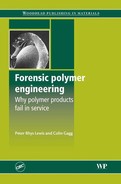0%
19Chapters
0-1Hours read
0kTotal Words
Book Description
Given the infinite number of applications of polymeric materials in everyday life, especially applications where a failure in service may lead to economic loss, injury or death, the ability to determine the cause of failure using forensic engineering techniques is essential. Forensic polymer engineering: Why polymer products fail in service reviews the latest forensic engineering techniques used in the investigation of failed polymer materials. It presents a series of case studies which illustrate the different types of failure and the forensic engineering techniques used in their investigation.The first chapters give an introduction to forensic polymer engineering and an overview of the examination and analysis of failed polymer components. Further chapters give detailed case studies of failure and forensic investigation of polymeric medical devices, polymer storage tanks, small polymeric containers, polymer pipes and fittings, polymeric seals, polymeric tools and ladders, polymer components in transport applications and polymer consumer products. A final concluding chapter provides information on causes of product failure and discusses poor manufacturing methods, poor design, poor choice of materials and failure due to insufficient account being taken of environmental factors.
With its distinguished authors, Forensic polymer engineering: Why polymer products fail in service is a standard reference for forensic experts practicing in all engineering fields that involve polymeric materials, as well as design and construction professionals, product manufacturers and insurance professionals.
- Reviews the latest forensic engineering techniques used in the investigation of failed polymer components
- Detailed case studies illustrate different types of failure in polymer components, fittings and medical devices
- Examines the role of manufacturing in product failure with an overview of faults recognised in methods, design and material selection
Table of Contents
- Cover image
- Title page
- Table of Contents
- Copyright
- Preface
- Acknowledgements
- Dedication
- Chapter 1: Introduction
- Chapter 2: Examination and analysis of failed components
- Chapter 3: Polymeric medical devices
- Chapter 4: Polymer storage tanks
- Chapter 5: Small polymeric containers
- Chapter 6: Polymeric pipes and fittings
- Chapter 7: Polymeric seals
- Chapter 8: Tools and ladders
- 8.1 Introduction
- 8.2 Failure of polypropylene hobby knives
- 8.3 Failure of polystyrene components in hobby knives
- 8.4 Failure of handles in angle grinders
- 8.5 Failure of security caps for gas cylinders
- 8.6 Failure of an ABS handle
- 8.7 Failure of chairs manufactured from polypropylene
- 8.8 Failure of swimming pool steps
- 8.9 Failed polyamide fittings in ladders
- 8.10 Conclusions
- Chapter 9: Components in transport applications
- Chapter 10: Consumer products
- Chapter 11: Conclusions
- Index
